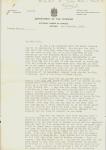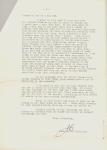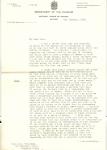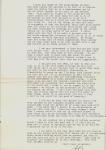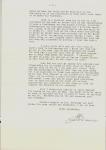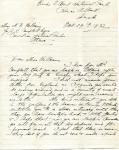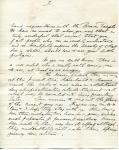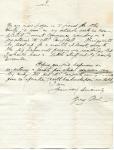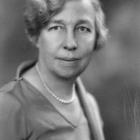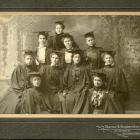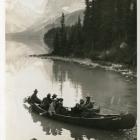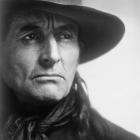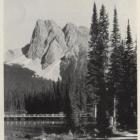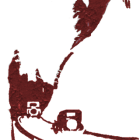Out-Grey-Owling Grey Owl
MB Williams had been living in London, England for four years when her past in parks caught up with her. J.C. Campbell, the man for whom she had been passed over as head of publicity at the Canadian Parks Branch, contacted her in late 1935 about the speaking tour that Grey Owl was about to begin in England. Grey Owl was the Indigenous nature writer whom the Parks Branch had taken under its wing in the early ‘30s, giving him a place to live at Riding Mountain National Park, Manitoba and then Prince Albert National Park, Saskatchewan, making him its spokesman for conservation. (That the Branch, having evicted Indigenous people in creating national parks, now saw value in hosting a single cultural representative of them, speaks to the way national parks were to be places associated with a symbolic indigeneity but not an actual Indigenous past or present.) The arrangement had been mutually beneficial, drawing international attention to both the Canadian park system and the Indigenous author. Except, of course, Grey Owl was not Indigenous at all, as the world would learn following his death in 1938: he was an Englishman, born Archie Belaney.
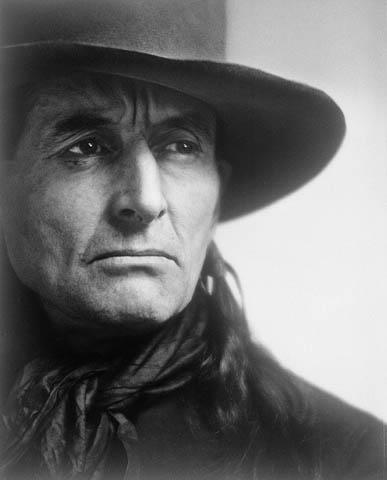
Grey Owl (Archibald Belaney), photographed by Yousuf Karsh
Grey Owl (Archibald Belaney), photographed by Yousuf Karsh
Courtesy of Library and Archives Canada, Acc. no. 1987-054, PA-164228. No restrictions on use. See http://collectionscanada.gc.ca/pam_archives/index.php?fuseaction=genitem….
 This work is licensed under a Creative Commons Public Domain Mark 1.0 License.
This work is licensed under a Creative Commons Public Domain Mark 1.0 License.
The remarkable series of four letters that Campbell wrote Williams in December 1935, January 1936, March 1936, and April 1936 offer the most candid record of the Parks Branch’s knowledge and opinion of Grey Owl—far more candid than anything found in the Branch’s own archival record. Campbell knew Grey Owl well, having “discovered” him for the Parks Branch by visiting the writer’s backwoods home and filming a short silent movie there, The Beaver People, which brought Grey Owl some of his earliest fame. While at the Parks Branch, Williams had gotten to know Grey Owl, too. In an October 1932 letter here, Grey Owl invited her, now that she was retired, to take the “long deferred and oft-promised visit” to see him, his wife, and “the Beaver People”—that is, his beaver pets.
In preparation for Grey Owl’s 1936 tour, Campbell asked Williams to do whatever she could do to keep the author out of trouble, to save the Canadian park system from potential embarrassment. The picture Campbell paints is of a Parks Branch terrified of what its increasingly celebrated spokesman, “either through liquor, women, or temper,” might say or do. To Campbell, he is a primadonna who feels he has moved beyond the nature writing, the park agency, and the nation that have made him famous: “He is obsessed with one idea and that is that he [is] a great backwoodsman. He … does not want to be known as an author as he thinks that is synonymous with being a crooner or gigolo par-fumier.” There is blunt mention of Grey Owl’s manipulative nature, his egotism, his drunkenness, his impatience for renown. And there is cryptic reference to worse. “There are many things I know that I cannot write to you,” Campbell writes, “and my constant prayer is that there will be no outbreak that would cast discredit on the National Parks and those with whom he is associated.” Although circumstantial, these letters are the strongest existing evidence that the Parks Branch, Grey Owl’s employer for a half-dozen years, knew full well before his death that he was a fraud.
As for MB, she was still loyal to the Parks Branch and so did as Campbell asked. She gave a talk about parks alongside Grey Owl, deflecting some of the attention away from him—she “out Grey Owled Grey Owl,” in Campbell’s congratulatory terms. And yet the publicity director warned her against doing more, fearing that becoming associated with Grey Owl would only embroil her in whatever future trouble was sure to come his way. “The unfortunate thing about it,” wrote Campbell, “is that while we know the truth now we will have to let him carry on if the Publishers so wish until such time as he meets his Waterloo.”
The original exhibition contains a dynamic gallery for viewing this multi-page document. It features four handwritten letters to MB Williams by J.C. Campbell and one letter written by Grey Owl.
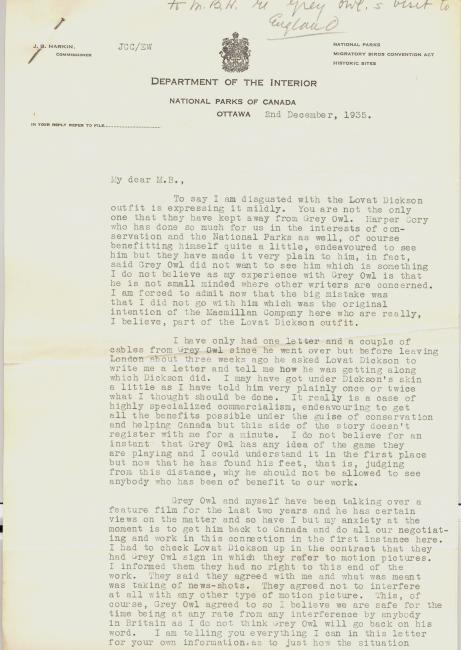
J. C. Campbell to MB Williams, 2 December 1935
[Letterhead]
Department of the Interior
National Parks of Canada
Ottawa
2nd December, 1935.
[Handwritten across the top] To M.B.W. re Grey Owl’s visit to England
My dear M.B.,
To say I am disgusted with the Lovat Dickson outfit is expressing it mildly. You are not the only one that they have kept away from Grey Owl. Harper Cory who has done so much for us in the interests of conservation and the National Parks as well, of course benefitting himself quite a little, endeavoured to see him but they have made it very plain to him, in fact, said Grey Owl did not want to see him which is something I do not believe as my experience with Grey Owl is that he is not small minded where other writers are concerned. I am forced to admit now that the big mistake was that I did not go with him which was the original intention of the Macmillan Company here who are really, I believe, part of the Lovat Dickson outfit.
I have only had one letter and a couple of cables from Grey Owl since he went over but before leaving London about three weeks ago he asked Lovat Dickson to write me a letter and tell me how he was getting along which Dickson did. I may have got under Dickson’s skin a little as I have told him very plainly once or twice what I thought should be done. It really is a case of highly specialized commercialism, endeavouring to get all the benefits possible under the guise of conservation and helping Canada but this side of the story doesn’t register with me for a minute. I do not believe for an instant that Grey Owl has any idea of the game they are playing and I could understand it in the first place but now that he has found his feet, that is, judging from this distance, why he should not be allowed to see anybody who has been of benefit to our work.
Grey Owl and myself have been talking over a feature film for the last two years and he has certain views on the matter and so have I but my anxiety at the moment is to get him back to Canada and do all our negotiating and work in this connection in the first instance here. I had to check Lovat Dickson up in the contract that they had Grey Owl sign in which they refer to motion pictures. I informed them they had no right to this end of the work. They said they agreed with me and what was meant was taking of news-shots. They agreed not to interfere at all with any other type of motion picture. This, of course, Grey Owl agreed to so I believe we are safe for the time being at any rate from any interference by anybody in Britain as I do not think Grey Owl will go back on his word. I am telling you everything I can in this letter for your own information as to just how the situation
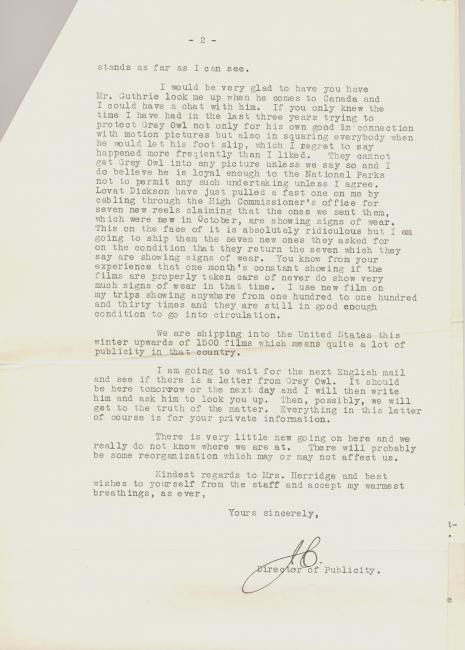
stands as far as I can see.
I would be very glad to have you have Mr. Guthrie look me up when he comes to Canada and I could have a chat with him. If you only knew the time I have had in the last three years trying to protect Grey Owl not only for his own good in connection with motion pictures but also in squaring everybody when he would let his foot slip, which I regret to say happened more freqiently than I liked. They cannot get Grey Owl into any picture unless we say so and I do believe he is loyal enough to the National Parks not to permit any such undertaking unless I agree. Lovat Dickson have just pulled a fast one on me by cabling through the High Commissioner’s office for seven new reels claiming that the ones we sent them, which were new in October, are showing signs of wear. This on the face of it is absolutely ridiculous but I am going to ship them the seven new ones they asked for on the condition that they return the seven which they say are showing signs of wear. You know from your experience that one month’s constant showing if the films are properly taken care of never do show very much sign of wear in that time. I use new film on my trips showing anywhere from one hundred to one hundred and thirty times and they are still in good enough condition to go into circulation.
We are shipping into the United States this winter upwards of 1500 films which means quite a lot of publicity in that country.
I am going to wait for the next English mail and see if there is a letter from Grey Owl. It should be here tomorrow or the next day and I will then write him and ask him to look you up. Then, possibly, we will get to the truth of the matter. Everything in this letter of course is for your private information.
There is very little new going on here and we really do not know where we are at. There will probably be some reorganization which may or may not affect us.
Kindest regards to Mrs. Herridge and best wishes to yourself from the staff and accept my warmest breathings, as ever,
Yours sincerely,
J.C.
Director of Publicity.
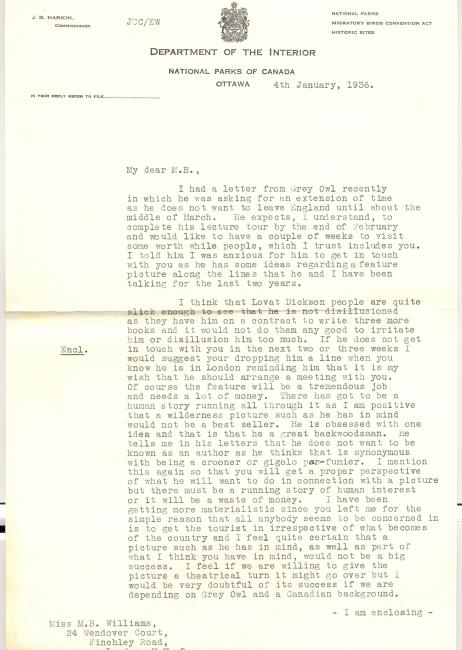
J. C. Campbell to MB Williams, 4 January 1936
[Letterhead]
Department of the Interior
National Parks of Canada
Ottawa
4th January, 1936.
My dear M.B.,
I had a letter from Grey Owl recently in which he was asking for an extension of time as he does not want to leave England until about the middle of March. He expects, I understand, to complete his lecture tour by the end of February and would like to have a couple of weeks to visit some worth while people, which I trust includes you. I told him I was anxious for him to get in touch with you as he has some ideas regarding a feature picture along the lines that he and I have been talking for the last two years.
I think that Lovat Dickson people are quite slick enough to see that he is not disillusioned as they have him on a contract to write three more books and it would not do them any good to irritate him or disillusion him too much. If he does not get in touch with you in the next two or three weeks I would suggest your dropping him a line when you know he is in London reminding him that it is my wish that he should arrange a meeting with you. Of course the feature will be a tremendous job and needs a lot of money. There has got to be a human story running all through it as I am positive that a wilderness picture such as he has in mind would not be a best seller. He is obsessed with one idea and that is that he a great backwoodsman. He tells me in his letters that he does not want to be known as an author as he thinks that is synonymous with being a crooner or gigolo par-fumier. I mention this again so that you will get a proper perspective of what he will want to do in connection with a picture but there must be a running story of human interest or it will be a waste of money. I have been getting more materialistic since you left me for the simple reason that all anybody seems to be concerned in is to get the tourist in irrespective of what becomes of the country and I feel quite certain that a picture such as he has in mind, as well as part of what I think you have in mind, would not be a big success. I feel if we are willing to give the picture a theatrical turn it might go over but I would be very doubtful of its success if we are depending on Grey Owl and a Canadian background.
— I am enclosing —
Miss M. B. Williams,
24 Wendover Court
Finchley Road,
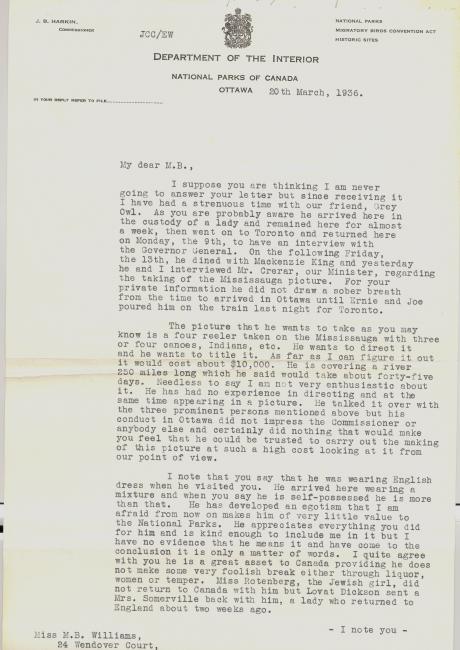
J. C. Campbell to MB Williams, 20 March 1936
[Letterhead]
Department of the Interior
National Parks of Canada
Ottawa
20th March, 1936.
My dear M.B.,
I suppose you are thinking I am never going to answer your letter but since receiving it I have had a strenuous time with our friend, Grey Owl. As you are probably aware he arrived here in the custody of a lady and remained here for almost a week, then went on to Toronto and returned here on Monday, the 9th, to have an interview with the Governor General. On the following Friday, the 13th, he dined with Mackenzie King and yesterday he and I interviewed Mr. Crerar, our Minister, regarding the taking of the Mississauga picture. For your private information he did not draw a sober breath from the time to arrived in Ottawa until Ernie and Joe poured him on the train last night for Toronto.
The picture that he wants to take as you may know is a four reeler taken on the Mississauga with three or four canoes, Indians, etc. He wants to direct it and he wants to title it. As far as I can figure it out it would cost about $10,000. He is covering a river 250 miles long which he said would take about forty-five days. He has had no experience in directing and at the same time appearing in the picture. He talked it over with the three prominent persons mentioned above but his conduct in Ottawa did not impress the Commissioner or anybody else and certainly did nothing that would make you feel that he could be trusted to carry out the making of this picture at such a high cost looking at it from our point of view.
I note that you say that he was wearing English dress when he visited you. He arrived here wearing a mixture and when you say he is self-possessed he is more than that. He has developed an egotism that I am afraid from now on makes him of very little value to the National Parks. He appreciates everything you did for him and is kind enough to include me in it but I have no evidence that he means it and have come to the conclusion it is only a matter of words. I quite agree with you he is a great asset to Canada providing he does not make some very foolish break either through liquor, women or temper. Miss. Rotenberg, the Jewish girl, did not return to Canada with him but Lovat Dickson sent a Mrs. Somerville back with him, a lady who returned to England about two weeks ago.
— I note you —
Miss. M. B. Williams,
24 Wendover Court,
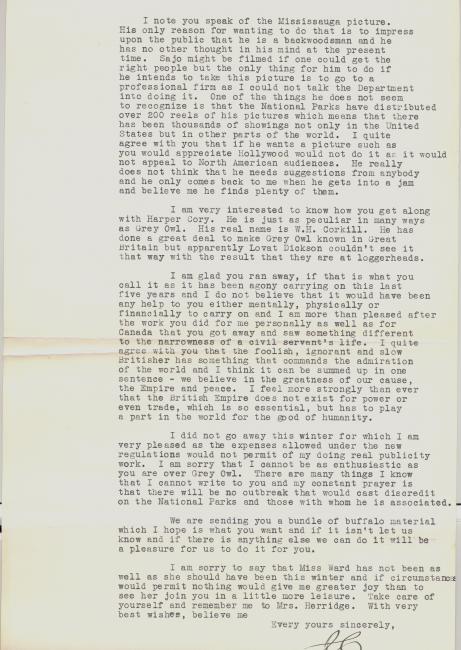
I note you speak of the Mississauga picture. His only reason for wanting to do that is to impress upon the public that he is a backwoodsman and he has no other thought in his mind at the present time. Sajo might be filmed if one could get the right people but the only thing for him to do if he intends to take this picture is to go to a professional firm as I could not talk the Department into doing it. One of the things he does not seem to recognize is that the National Parks have distributed over 200 reels of his pictures which means that there has been thousands of showings not only in the United States but in other parts of the world. I quite agree with you that if he wants a picture such as you would appreciate Hollywood would not do it as it would not appeal to North American audiences. He really does not think that he needs suggestions from anybody and he only comes back to me when he gets into a jam and believe me he finds plenty of them.
I am very interested to know how you get along with Harper Cory. He is just as peculiar in many ways as Grey Owl. His real name is W.H. Corkill. He has done a great deal to make Grey Owl known in Great Britain but apparently Lovat Dickson couldn’t see it that way with the result that they are at loggerheads.
I am glad you ran away, if that is what you call it as it has been agony carrying on this last five years and I do believe that it would have been any help to you either mentally, physically or financially to carry on and I am more than pleased after the work you did for me personally as well as for Canada that you got away and saw something different to the narrowness of a civil servant’s life. I quite agree with you that the foolish, ignorant and slow Britisher has something that commands the admiration of the world and I think it can be summed up in one sentence — we believe in the greatness of our cause, the Empire and peace. I feel more strongly than ever that the British Empire does not exist for power or even trade, which is so essential, but has to play a part in the world for the good of humanity.
I did not go away this winter for which I am very pleased as the expenses allowed under the new regulations would not permit of my doing real publicity work. I am sorry that I cannot be as enthusiastic as you are over Grey Owl. There are many things I know that I cannot write to you and my constant prayer is that there will be no outbreak that would cast discredit on the National Parks and those with whom he is associated.
We are sending you a bundle of buffalo material which I hope is what you want and if it isn’t let us know and if there is anything else we can do it will be a pleasure for us to do it for you.
I am sorry to say that Miss Ward has not been as well as she should have been this winter and if circumstances would permit nothing would give me greater joy than to see her join you in a little more leisure. Take care of yourself and remember me to Mrs. Herridge. With very best wishes, believe me
Ever yours sincerely,
JC

J. C. Campbell to MB Williams, 16 April 1936
[Letterhead]
Department of the Interior
National Parks of Canada
Ottawa
16th April, 1936.
My dear M.B.,
Congratulations. I have information that you have out Grey Owled Grey Owl and I understand that you were a big success at the National Council meeting.
There is one thing that you have got to do, however, and I feel you appreciate this and that is, go slowly and take real care. I got quite a thrill out of hearing that you were so much appreciated. Of course the thing is now that they will want you to talk frequently which you must not do.
Your letter just bore out every conviction that I have arrived at in connection with our gentleman friend. So far there has been nothing done about the picture and I am certainly not going to be a party to spending any Government money in which he directs and has much to say about it. As far as Government work is concerned I look upon him as being practically ruined and J.B. feels the same way bout it. If he wishes to take it on his own with the Publishers money let him go to it but we are certainly not in favour of allowing Grey Owl and his connections spending money on a picture which would not be along the lines that we want.
I have not seen Hugh Eayrs of the Macmillan Company since Grey Owl returned but I believe that he will be quite in agreement with us in this matter.
The Jewish lady is the daughter of a pretty well to do Insurance Broker in the city of Toronto and Grey Owl while in Toronto stayed in their home. Personally, I do not think that she has any other idea but to make money out of him and he is just egotistic enough to think she is doing this for personal liking. I am not a darn bit sorry for Lovat Dickson. In the first place he didn’t play the game when the arrangements were made for the tour and he tried to use great pressure through the High Commissioner’s office in London which didn’t have any effect here as the arrangements for Grey Owl’s leave had already been made. Grey Owl has no idea of talking about anybody or anything but Grey Owl and he also informed me how much good he has done for Canada. He told me one morning that he had got practically above this beaver stuff so I take it that from a National Parks standpoint you can count him out. The unfortunate thing about it is that
— while —
Miss. M. B. Williams,
24 Wendover Court,
London
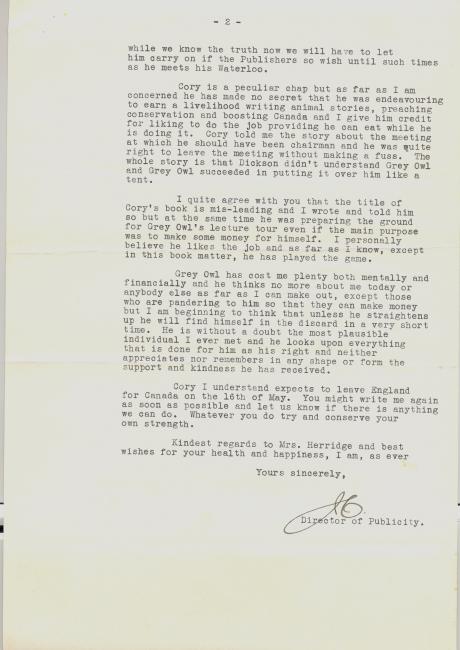
while we know the truth now we will have to let him carry on if the Publishers so wish until such times as he meets his Waterloo.
Cory is a peculiar chap but as far as I am concerned he has made no secret that he was endeavouring to earn a livelihood writing animal stories, preaching conservation and boosting Canada and I give him credit for liking to do the job providing he can eat while he is doing it. Cory told me the story about the meeting at which he should have been chairman and he was quite right to leave the meeting without making a fuss. The whole story is that Dickson didn’t understand Grey Owl and Grey Owl succeeded in putting it over him like a tent.
I quite agree with you that the title of Cory’s book is mis-leading and I wrote and told him so but at the same time he was preparing the ground for Grey Owl’s lecture tour even if the main purpose was to make some money for himself. I personally believe he likes the job and as far as I know, except in this book matter, he has played the game.
Grey Owl has cost me plenty both mentally and financially and he thinks no more about me today or anybody else as far as I can make out, except those who are pandering to him so that they can make money but I am beginning to think that unless he straightens up he will find himself in the discard in a very short time. He is without doubt the most plausible individual I ever met and he looks upon everything that is done for him as his right and neither appreciates nor remembers in any shape or form the support and kindness he has received.
Cory I understand expects to leave England for Canada on the 16th of May. You might write me again as soon as possible and let us know if there is anything we can do. Whatever you do try and conserve your strength.
Kindest regards to Mrs. Herridge and best wishes for your health and happiness, I am, as ever
Yours sincerely,
JC
Director of Publicity.
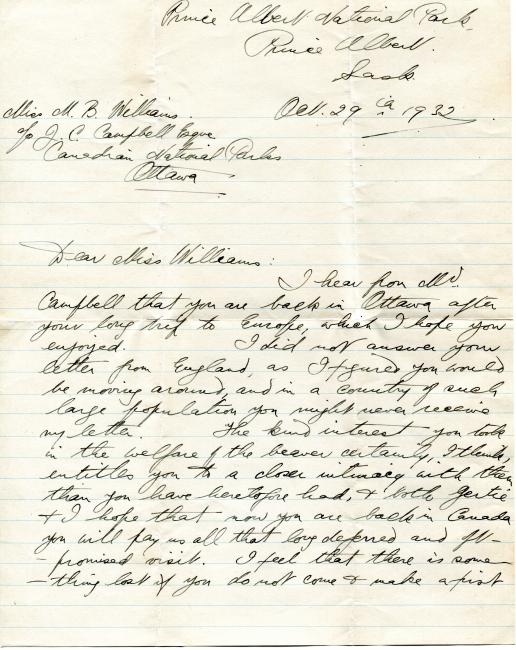
Grey Owl to MB Williams, 29 October 1932
Prince Albert National Park
Prince Albert
Sask.
Oct. 29th 1932
Miss MB Williams
c/o JC Campbell, Esqre
Canadian National Parks
Ottawa
Dear Miss Williams:
I hear from Mr. Campbell that you are back in Ottawa after your long trip to Europe, which I hope you enjoyed. I did not answer your letter from England, as I figured you would be moving around, and in a country of such large population you might never receive my letter. The kind interest you took in the welfare of the beaver certainly, I think, entitles you to a closer intimacy with them than you have heretofore had, & both Gertie & I hope that now you are back in Canada you will pay us all that long deferred and oft-promised visit. I feel that there is something lost if you do not come & make a first
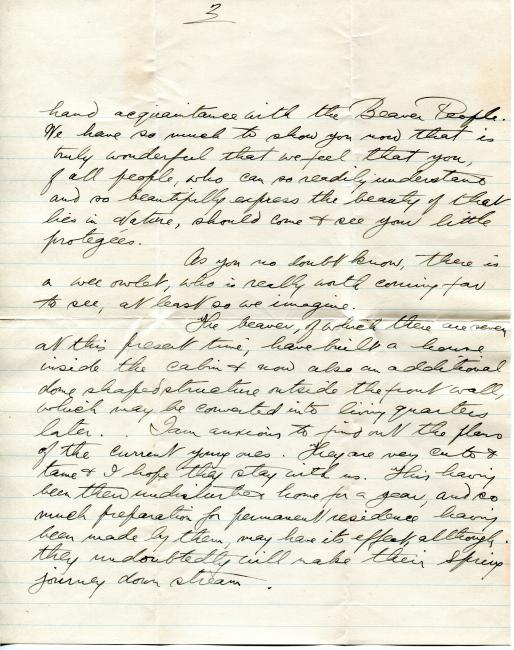
hand acquaintance with the Beaver People. We have so much to show you now that is truly wonderful that we feel that you, of all people, who can so readily understand and so beautifully express the beauty of that lies in Nature, should come & see your little protégées.
As you no doubt know, there is a wee owlet, who is really worth coming far to see, at least so we imagine.
The beaver, of which there are seven at this present time, have built a house inside the cabin & now also an additional dome shaped structure outside the front wall, which may be converting into living quarters later. I am anxious to find out the plans of the current young ones. They are very cute & tame & I hope they stay with us. This having been their undisturbed home for a year, and so much preparation for permanent residence having been made by them, may have its effect, although they undoubtedly will make their Spring journey down stream.
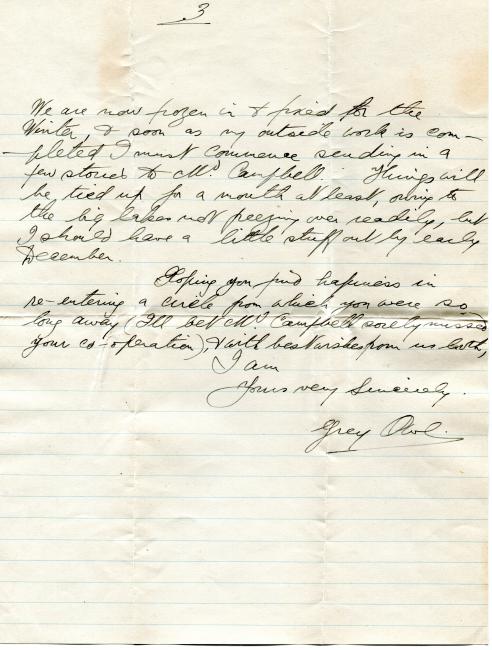
We are now frozen in & fixed for the Winter, & soon as my outside work is completed I must commence sending in a few stories to Mr. Campbell. Things will be tied up for a month at least, owing to the big lakes not freezing over readily, but I should have a little stuff out by early December.
Hoping you find happiness in re-entering a circle from which you were so long away (I’ll bet Mr. Campbell sorely misses your co-operation), & with best wishes from us both,
I am
Yours very sincerely,
Grey Owl
